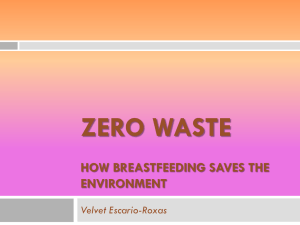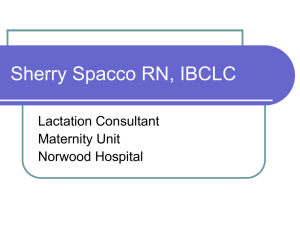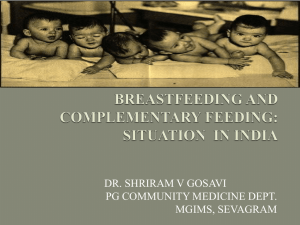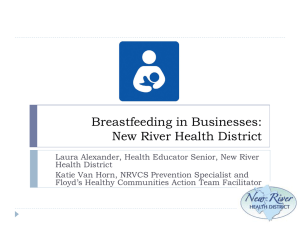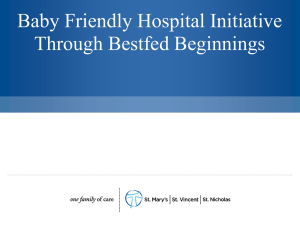Breastfed – formula-fed
advertisement
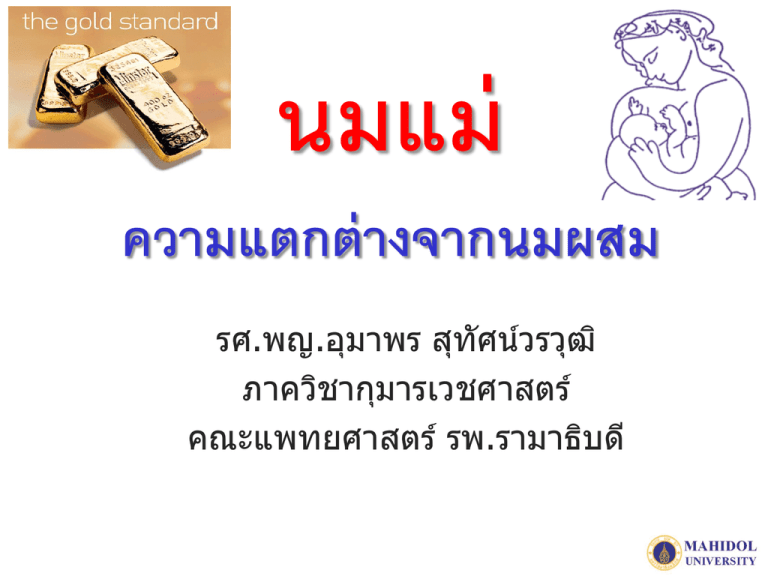
นมแม่ ความแตกต่ างจากนมผสม รศ.พญ.อุมาพร สุทัศน์วรวุฒ ิ ภาควิชากุมารเวชศาสตร์ คณะแพทยศาสตร์ รพ.รามาธิบดี โอกาสทองของการพัฒนาสมอง “หน้ าต่ างเวลา 5 บาน” window-time period ดีบุก ทองแดง เงิน ทองคา ทองคาขาว 0 1/2 6 12 โอกาสทองของการพัฒนาสมอง เพื่อการเรี ยนรู้ 25 75 ปี ประเสริฐ บุญเกิด และคณะ. เล่ นตามรอยพระยุคลบาท 2551 อาหารทารก ความต้องการอาหาร (%) 100 80 ระยะหย่ านม อาหารตามวัย นา้ นมแม่ 60 อาหารหลัก 40 20 0 0 0.5 1 อายุ (ปี ) 1.5 2 นมไหนใครว่าแน่.. นมแม่แน่กว่าใคร เหตุผลทางการแพทย์ที่มารดาควรงดการให้ นมแม่ • Infants with certain heritable metabolic disorders: galactosemia, maple syrup urine disease, phenylketouria • Maternal HIV infection if replacement feeding is acceptable, feasible, affordable, sustainable, and safe • Maternal conditions justifying temporary avoidance of breastfeeding eg. – – – – Radioactive iodine-131 Cytotoxic chemotherapy Sedating psychotherapeutic drugs Excessive use of topical iodine 2009 ประโยชน์ ประหยัด ปลอดภัย นมแม่ VS นมผสม ปฏิบัตไิ ด้ มาตรฐานและความปลอดภัย • ประกาศกระทรวงสาธารณสุข • Codex Standard 72 of the Codex Alimentarius (Latin for “food code”) ของ FAO และ WHO ระบุมาตรฐานของ ส่ วนประกอบ คุณภาพ และความปลอดภัยที่ต้องการของ นมดัดแปลงสาหรับทารก • ปั ญหา: การทาผิดกฎหมาย จุลินทรีย์ สารปนเปื ้ อน สาร ตกค้ าง ประกาศกระทรวงสาธารณสุข เรื่อง นมดัดแปลงสาหรับทารก และนมดัดแปลงสูตรต่ อเนื่องสาหรับทารกและเด็กเล็ก • ฉบับที่ 156 (พ.ศ.2537) เรื่อง นมดัดแปลงสาหรับทารกและนม ดัดแปลงสูตรต่ อเนื่องสาหรับทารกและเด็กเล็ก • ฉบับที่ 286 (พ.ศ.2547) เรื่อง นมดัดแปลงสาหรับทารกและนม ดัดแปลงสูตรต่ อเนื่องสาหรับทารกและเด็กเล็ก (ฉบับที่ 2) • ฉบับที่ 287 (พ.ศ.2547) เรื่อง อาหารทารกและอาหารสูตรต่ อเนื่อง สาหรับทารกและเด็กเล็ก (ฉบับที่ 3) • ฉบับที่ 307 (พ.ศ.2550) เรื่อง นมดัดแปลงสาหรับทารกและนม ดัดแปลงสูตรต่ อเนื่องสาหรับทารกและเด็กเล็ก (ฉบับที่ 3) ประกาศกระทรวงสาธารณสุข ฉบับที่ 307 (พ.ศ.2550) ข้ อความบนฉลาก ? “สิ่งสาคัญที่ควรทราบ • นมแม่ เป็ นอาหารที่ดีท่ สี ุดสาหรั บทารก เพราะมีคุณค่ าทางโภชนาการครบถ้ วน • นมดัดแปลงสาหรั บทารก ควรใช้ ตามคาแนะนาของแพทย์ พยาบาล หรื อนัก โภชนาการ • การเตรี ยมหรื อใช้ ส่วนผสมไม่ ถูกต้ องจะเป็ นอันตรายต่ อทารก” ทัง้ นี ้ การแสดงข อความทัง้ 3 ข อความให เรี ยงกันลงมา โดยอยู ในกรอบ เดียวกัน สีของตัวอักษรตัดกับสีพนื ้ ของกรอบ เฉพาะข อความแรกให แสดงด วย ตัวอักษร หนาทึบเห็นได ชัดเจน โภชนาการ ภูมต ิ ้านทาน พัฒนา สมอง สุขภาพระยะ ยาว แม่ลก ู ผูกพัน คุณค่าทางโภชนาการของนมแม่ เปรียบเทียบส่ วนประกอบของนา้ นมสัตว์ (g/dL) Protein Lactose Fat Ash Human 1.0 7.0 3.8 0.2 Cow Goat Sheep Buffalo Ass Horse 3.2 2.9 4.1 4.3 1.4 1.9 4.6 4.7 5.0 4.9 6.1 6.9 3.7 3.8 7.3 6.5 0.6 1.3 0.7 0.8 0.8 0.8 0.4 0.4 Reindeer 9.5 3.4 10.9 1.3 Jenness R,1974; Oftedal OT, 1984. เปรี ยบเทียบสารอาหารในนมแม่ กับนมวัว (ต่ อดล.) และมาตรฐาน Codex ของนมดัดแปลงสาหรั บทารก ส่ วนประกอบ พลังงาน (kcal) ไขมัน (g) คาร์ โบไฮเดรต(g) •แลคโตส (g) •Oligosaccharides (g) •กลูโคส (g) หัวนา้ นม Mature milk นมวัว มาตรฐาน Codex 58 65-70 64 60-70 1.5-2 3.5-4.8 3.7 2.95-4 5-7 7-8.5 4.65 6-9.4 2-5 6.7-7 4.5 2.2-2.4 1.2-1.4 Trace 0.02-0.1 0.02-0.03 NR สารอาหารในนมแม่ และนมวัว (ต่ อดล.) และมาตรฐาน Codex ของนมดัดแปลงสาหรับทารก ส่ วนประกอบ Total protein (g) Casein (g) หัวนา้ นม 1.5-2 0.4 Mature milk 0.8-1.1 0.3-0.5 นมวัว 3.2-3.5 2.7 Whey protein (g) •Alpha-lactalbumin (g) •Beta-lactoglobulin (g) 1.1-1.5 0.36 - 0.5-0.6 0.2-0.3 - 0.5 0.1 0.36 0.35 0.01-0.02 0.4 0.1-0.3 0.01 0.3 Trace Trace 0.04 0.2-1.2 0.002 0.001 0.05-0.1 0.001 0.005 0.003 0.006 0.003 0.05 0.045 0.02 •Lactoferrin (g) •Lysozyme (g) •Serum albumin (g) •sIgA (g) •IgM (g) •IgG (g) •Non-protein N (g) Codex 1.2-2 นมแม่มีส่วนประกอบแตกต่างกัน (dynamic) Gestational age at birth (preterm and full term) Stage of lactation (colostrum and mature milk) During a feed (foremilk and hindmilk) DHA and arachidonic acid concentrations in human breast milk worldwide Primary analysis of 106 studies Final analysis of 65 studies (2,474 free-living mothers) Using modern capillary gas chromatography analysis Brenna, J T. et al. Am J Clin Nutr 2007;85:1457-1464 DHA and arachidonic acid concentrations in human breast milk worldwide Mean + SD concentration DHA 0.32 + 0.22% (range: 0.06-1.4) AA 0.47 + 0.13% (range: 0.24-1.0) The highest DHA concentrations in coastal populations, associated with marine food consumption Mean ratio of DHA:AA varies widely Brenna, J T. et al. Am J Clin Nutr 2007;85:1457-1464 Protective factors in breast milk Antimicrobial factors eg. sIgA, leukocytes, lysozyme, lactoferrin, cytokines Modulation of GI barrier & flora eg. Growth factors, nucleotides, prebiotics Anti-inflammatory effect TGF-beta, erythropoietin, IL-10, lactoferrin, omega-3 fatty acids Promotion of tolerance By traces of food proteins from maternal diet The WHO life-course model: Non-communicable diseases Aboderin I, et al. WHO 2001. ผลดีระยะยาวของการเลีย้ งลูกด้ วยนมแม่ Systematic review World Health Organization 2007 World Health Organization 2013 ผลดีระยะยาวของการเลีย ้ งลูกด ้วยนมแม่ Breastfeeding Outcome Pooled effect size (95% confidence interval) The effect of breastfeeding is significant, but smaller than the effect of other interventions Blood pressure (mean diff in mm Hg, 95% CI) Systolic -1.21 (-1.72 to -0.70) Diastolic -0.49 (-0.87 to -0.11) Total serum cholesterol (mean diff in mmol/L, 95% CI) Conclusion -0.18 (-0.30 to -0.06) The effect of breastfeeding is significant and larger than the effect of other interventions Overweight or obesity Odds ratio 0.78 (0.72 to 0.84) The effect of breastfeeding is significant (22% reduction), while other interventions showed no effect Type II diabetes Odds ratio 0.63 (0.45 to 0.89) The effect of breastfeeding is significant (37% reduction) and of similar magnitude to the effect of other interventions Intelligence test scores Mean difference 4.9 points (2.97 to 6.92) World Health Organization 2007 The effect of breastfeeding is significant, with a substantial effect size ผลดีระยะยาวของการเลีย ้ งลูกด ้วยนมแม่ Breastfeeding Outcome Pooled effect size (95% confidence interval) Conclusion The effect of breastfeeding is significant, but smaller than the effect of other interventions Blood pressure (mean diff in mm Hg, 95% CI) Systolic -0.71 (-1.24 to -0.19) Small reduction of <1mmHg Diastolic -0.27 (-0.64 to 0.09) No significant protection 0.00 (-0.02 to 0.02) No effect Odds ratio 0.88 (0.83 to 0.93) The effect of breastfeeding is significant (12% reduction) but residual confounding cannot be ruled out Odds ratio 0.66 (0.49 to 0.89) The effect of breastfeeding is significant (34% reduction). Only 2 high-quality studies, with conflicting results. Need further studies Total serum cholesterol (mean diff in mmol/L, 95% CI) Overweight or obesity Type II diabetes (All studies) Intelligence test scores Mean difference 2.19 points (0.89 to 3.5) World Health Organization 2013 Breastfeeding was associated with an increase of 2.2 points. 2 randomized trials found significant effects. Strong evidence of a causal effect of BF on IQ. Breastfeeding and cognitive development: meta-analysis 3.16 Anderson JW, et al. Am J Clin Nutr 1999. Breastfeeding and cognitive development: meta-analysis Age category Breastfed Formula fed Mean difference* 95% CI 6-12 m (n=7) 2-5 y (n=12) 2283 3674 1169 5166 3.11 1.82, 4.39 1.86, 3.20 6-9 y (n=5) 10-15 y (n=2) 1575 1116 1461 4120 * Breastfed – formula-fed Anderson JW, et al. Am J Clin Nutr 1999. 2.53 3.01 3.19 1.99, 4.03 1.89, 4.48 Breastfeeding and cognitive development: meta-analysis Birth weight Normal or mixed (n=22) Low (n=6) Breastfed Formula fed Mean difference* 95% CI 8922 5778 2.66 2.15, 3.17 1294 751 5.18 3.59, 6.77 * Breastfed – formula-fed Anderson JW, et al. Am J Clin Nutr 1999. Breastfeeding and cognitive development: meta-analysis Duration of breastfeeding Subjects by feeding Mean status difference * Breastfed Formula fed 95% CI 4-7 wk 8-11 wk 12-19 wk 2609 3070 2458 8413 10198 9569 -0.02 1.68 2.15 -0.71, 0.67 1.12, 2.25 1.41, 2.88 20-27 wk 1232 2910 2767 1840 2.78 2.91 1.94, 3.61 1.73, 4.09 28 wk * Breastfed – formula-fed Anderson JW, et al. Am J Clin Nutr 1999. Long-chain polyunsaturated fatty acids (LCPUFAs) • Arachidonic acid (AA) – 20:4 n-6 • Docosahexaenoic acid (DHA) – 22:6 n-3 • Essential for the development of brain and retina DHA (Docosahexaenoic Acid) • Important component of structural lipid of brain and retina • DHA supplementation of breastfeeding mothers increases DHA in breast milk and infant plasma phospholipid. Jensen CL, et al. AJCN 2000; 71:292S. Synthesis of long-chain n-6 and n-3 PUFA Vegetable oils, nuts, seeds Some vegetable oils, nuts, seeds Fish EPA Fish, eggs, poultry DHA Wanten G, et al. Am J Clin Nutr 2007. LCPUFA supplementation in term infants: Meta-analysis • 15 randomised trials (n= 1,889) • Assessment of visual acuity, neurodevelopmental outcome, physical growth • Majority of the RCTs have not shown beneficial effects on neurodevelopmental outcome • Beneficial effects on visual acuity have not been consistently demonstrated • No benefit or harm on physical growth Cochrane Database of Systematic Review 2011 How the behavioral pattern of the mother can be either a confounder or a mediator Behavioral pattern of the mother Support and stimulation of child Breast feeding Cognitive development Oxytocin Prolactin Bonding Affectionate touch Less depression Behavioral pattern of the mother Michaelsen KF, et al. 2009. Does breastfeeding prevent allergy? Does breastfeeding prevent allergy? • Yes: Systematic reviews& meta-analysis of observational studies show protective effect of exclusive breastfeeding for at least 4 months • No: RCT from Belarus show no difference between intervention and control groups regarding prevalence of allergy & positive skin prick test up to age 6 years Does breastfeeding prevent allergy? • Limitations – Unethical to conduct randomized controlled trials – Variation in breast milk composition – Maternal diet • Probiotics: Live microorganisms which when administered in adequate amounts confer a health benefit on the host Joint FAO/WHO Expert Consultation 2001 • Prebiotics: Non-digestible food ingredients that beneficially affect the host by selectively stimulating the growth and/or activity of one/a limited number of bacteria in colon having the potential to improve host health Joint FAO/WHO Expert Consultation 2001 • Synbiotics: A mixture of probiotics and prebiotics which beneficially affects host by improving survival and implantation of friendly flora in GI tract Joint FAO/WHO Expert Consultation 2001 Synbiotics, probiotics or prebiotics in infant formula for term infants: a systematic review • Randomized controlled trials • 3 synbiotic studies (n = 475), 10 probiotic studies (n= 933), 12 prebiotic studies (n= 1,563) • Not enough evidence for improved growth or clinical outcomes Mugambi MN, et al. Nutr J 2012 ตัวอย่ างอาหารที่ควรเพิ่มใน1วันสาหรั บแม่ ท่ ใี ห้ นมลูก (ประมาณ 500 กิโลแคลอรี โปรตีน 25 กรั ม) นม 1 แก้ ว ข้ าวสวย 2 ทัพพี เนือ้ สัตว์ สุก 4 ช้ อนโต๊ ะ ผักและผลไม้ อย่ างละ 1 ส่ วน หรื อ นม 1 แก้ ว และ ก๋ วยเตี๋ยวนา้ 1 ชาม แนวทางการแก้ ไขปั ญหาการขาดไอโอดีน กระทรวงสาธารณสุขออกประกาศ กฎกระทรวงใหม่ มีผลบังคับใช้ ตงั ้ แต่ 31 ธค. 2553 ให้ เกลือ นา้ ปลา นา้ เกลือปรุ ง อาหาร และผลิตภัณฑ์ ปรุ งรสต้ องผสม ไอโอดีนตามปริมาณที่กาหนด (เกลือ เสริมไอโอดีนถ้ วนหน้ า, universal iodization) การให้ ไอโอดีนเสริมในหญิงตัง้ ครรภ์ หญิงให้ นมบุตรและเด็กเล็ก นโยบายกระทรวงสาธารณสุข ตัง้ แต่ 1 ตุลาคม 2553 หญิงตัง้ ครรภ์ ทุกคนได้ รับยาเม็ดเสริมไอโอดีนฟรี จนถึงระยะ ให้ นมบุตรถึง 6 เดือน องค์ การเภสัชกรรมผลิตยาเม็ดวิตามินและเกลือแร่ สาหรับ หญิงตัง้ ครรภ์ และหญิงให้ นมบุตร Triferdine 150: Iodine 150 mcg, iron 60 mg, folic acid 400 mcg Iodine GPO 150: Iodine 150 mcg ใช้ สาหรั บหญิง ตัง้ ครรภ์ และหลังคลอดที่เป็ นโรคธาลัสซีเมียรุ นแรงและเสี่ยงต่ อ การได้ ธาตุเหล็กมากเกินไป ความหว ังของพ่ อ แม่ Smart Breastfeeding, ความหว ังของชาติ Smart Citizens ดี เก่ ง มีสุข

